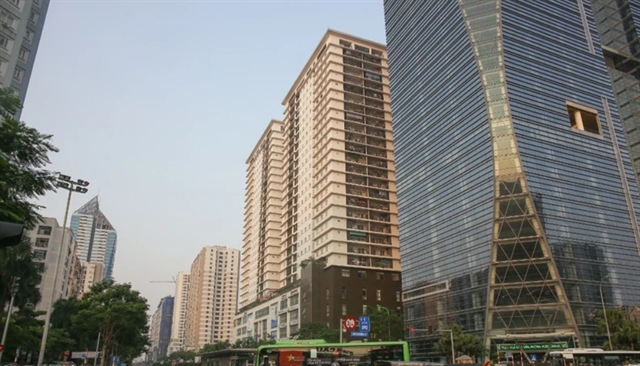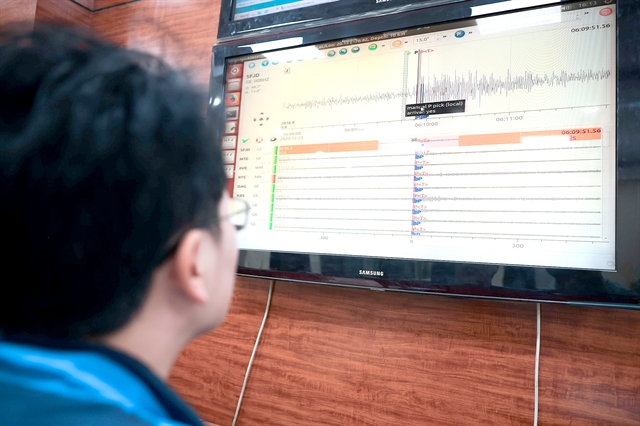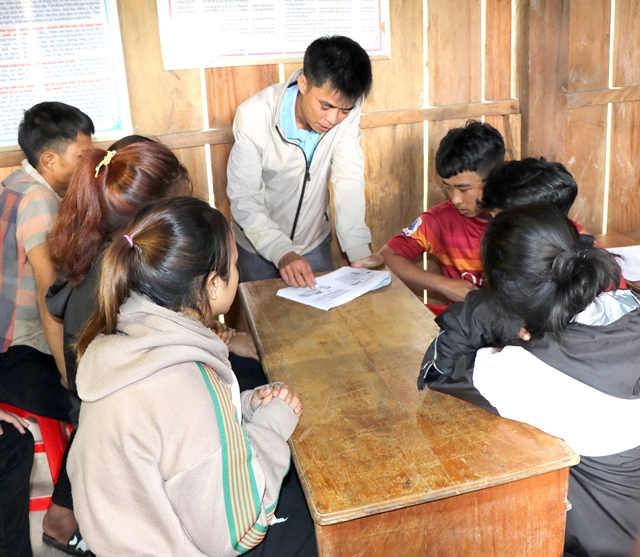 Environment
Environment

 |
| A scientist conducts research on location, magnitude and depth of earthquakes at the Việt Nam Academy of Science and Technology. — VNAVNS Photo Hoàng Hiếu |
HÀ NỘI — Although Việt Nam is not located in an area with high risk of earthquakes, experts believe that specific research and surveys are still needed to apply prevention and control solutions.
At noon last Friday, when a 7.7 Richter earthquake hit Myanmar, although HCM City was about 1,700km from the epicentre, it also suffered some damage.
Residents at the Sài Gòn South Residences apartment building in Nhà Bè District recorded a loud noise in block D and then a long crack appeared in the walls.
Two days later, at Diamond Riverside apartment building in Ward 16, District 8, nearly 350 apartments were affected by the earthquake.
Cracks appeared in the walls of Võ Thị Mộng Tuyền's apartment on the 27th floor in Building C1, along with peeling tiles and warped floors.
Not only block C but also block A also recorded similar cases. Đào Kim Luân, a resident, said that on the 15th floor, the cracks formed vertically with an average length of between one and two metres.
In addition to HCM City, earthquake tremors were also recorded in other localities such as Hà Nội and Cần Thơ City.
In Hà Nội, strong tremors occurred in districts such as Thanh Xuân, Hai Bà Trưng and Đống Đa causing some residents to panic and seek shelter.
Some high-rise buildings and offices in the centre of Cần Thơ City shook, forcing residents to flee to the ground to ensure safety.
Small and infrequent risk
The Director of the Earthquake and Tsunami Warning Centre under the Việt Nam Academy of Science and Technology, Nguyễn Xuân Anh, said that data showed that earthquakes had occurred many times in Việt Nam, but they are basically small.
Compared to other countries in the region, the risk of earthquakes in Việt Nam is also smaller in scale and frequency.
Normally, earthquakes are located in areas at the boundary of large continental plates. When the plates collide with each other, it will cause terrible earthquakes. Myanmar or Türkiye are countries that fall into this category. In addition, earthquakes also occur in volcanic belts such as in Japan, the Philippines and Indonesia.
"It can be seen that earthquakes often occur in areas with complex terrain, where plains and mountains meet, with a variety of heights. Therefore, in Việt Nam, the epicentre of some earthquakes is often in the northwest and Central Highlands regions,” he said.
“Việt Nam is also located deep in the intraplate area of continental boundaries and does not have a ring of fire, so our earthquake risk is small and less than in other countries," Anh explained.
But Anh recommended that Việt Nam still should have specific, appropriate solutions for each area and specific construction.
A 7.7-magnitude earthquake can potentially cause damage to the safety of 250,000 people, causing damage to many or all constructions in many areas. Some of these constructions will partially collapse or be severely damaged. Even well-designed constructions can still be affected.
In addition to the distance and intensity of the earthquake, it also depends on the soil of each area and especially on each specific construction. Constructions that are well-built and have high seismic resistance will be less affected and vice versa.
"For example, in Myanmar, where there is a high risk, it is necessary to build solid structures to withstand strong earthquakes. Although Việt Nam does not have a very high risk of earthquakes, when constructing structures, especially large structures, it is necessary to assess the environment, especially the risk of earthquakes and tsunamis, because this is an important and long-term economic problem," said Anh.
He added that after the recent earthquake, it could be seen that HCM City has many structures with high risks. Therefore, it was necessary to have a programme to assess risks related to earthquakes for sustainable development.
For future high-rise buildings and apartments, there should be monitoring equipment to assess the level of earthquake resistance. People should also equip themselves with knowledge about earthquake prevention so that when an incident occurs, they will know how to respond appropriately.
Earthquake-proof standards
 |
| An official instructs people on how to respond when an earthquake occurs in Đăk Tăng Commune, Kon Plông District, the Central Highlands province of Kon Tum. — VNAVNS Photo Cao Nguyên |
Associate Professor Lê Anh Tuấn, former Deputy Director of the Institute for Climate Change Research under the Cần Thơ University, said that according to scientific and historical documents recorded in Việt Nam, earthquakes tended to occur in the northwest region and the Central Highlands.
Earthquakes in the Central Highlands in recent years were often caused by the influence of hydroelectric reservoirs causing stimulated earthquakes. They would gradually decrease over time when the earth's crust in that area stabilises again.
"Although Việt Nam has low risk of earthquakes, I remember that Cần Thơ University has some projects in cooperation with Japan, and when constructing, they also applied earthquake-proof standards. Currently, Việt Nam does not have such standards in construction. The recent earthquake could be a warning for us, especially for large-scale construction projects in places with weak ground," Tuấn suggested.
Architect Ngô Viết Nam Sơn also has a similar opinion.
Việt Nam's history has not recorded any major earthquakes, so the design factor to prevent earthquake risks has not been included in the construction standards.
At present, high-rise buildings in Việt Nam hardly focus on earthquake resistance.
"In the current context of many changes in climate and geology, I think there needs to be preparation to deal with these risks,” said Sơn.
For example, he said, San Francisco in California, the US suffered earthquakes that destroyed the city centre. After that, when rebuilding, earthquake resistance standards were included in the buildings.
“Their construction standards are quite detailed, ordinary residential houses do not encourage solid construction with reinforced concrete but mainly with lightweight materials, especially wood,” said Sơn.
But, he added, Việt Nam should not rush to apply the above standards mechanically, because there are many ways to prevent earthquakes, most of these solutions are quite expensive.
The country needs to conduct extensive research and assessment on a national scale, according to Sơn.
"For Việt Nam, I think that the first step is for geological agencies to provide scientific research on the risk of earthquakes. Especially the frequency of occurrence in 100 years, in which areas, at what level.
"There must be an assessment of the risk of earthquakes in each province and city, which areas are at risk of earthquakes in the next 100 years? On that basis, appropriate standards should be added for each specific area and each type of construction," he said. — VNS




